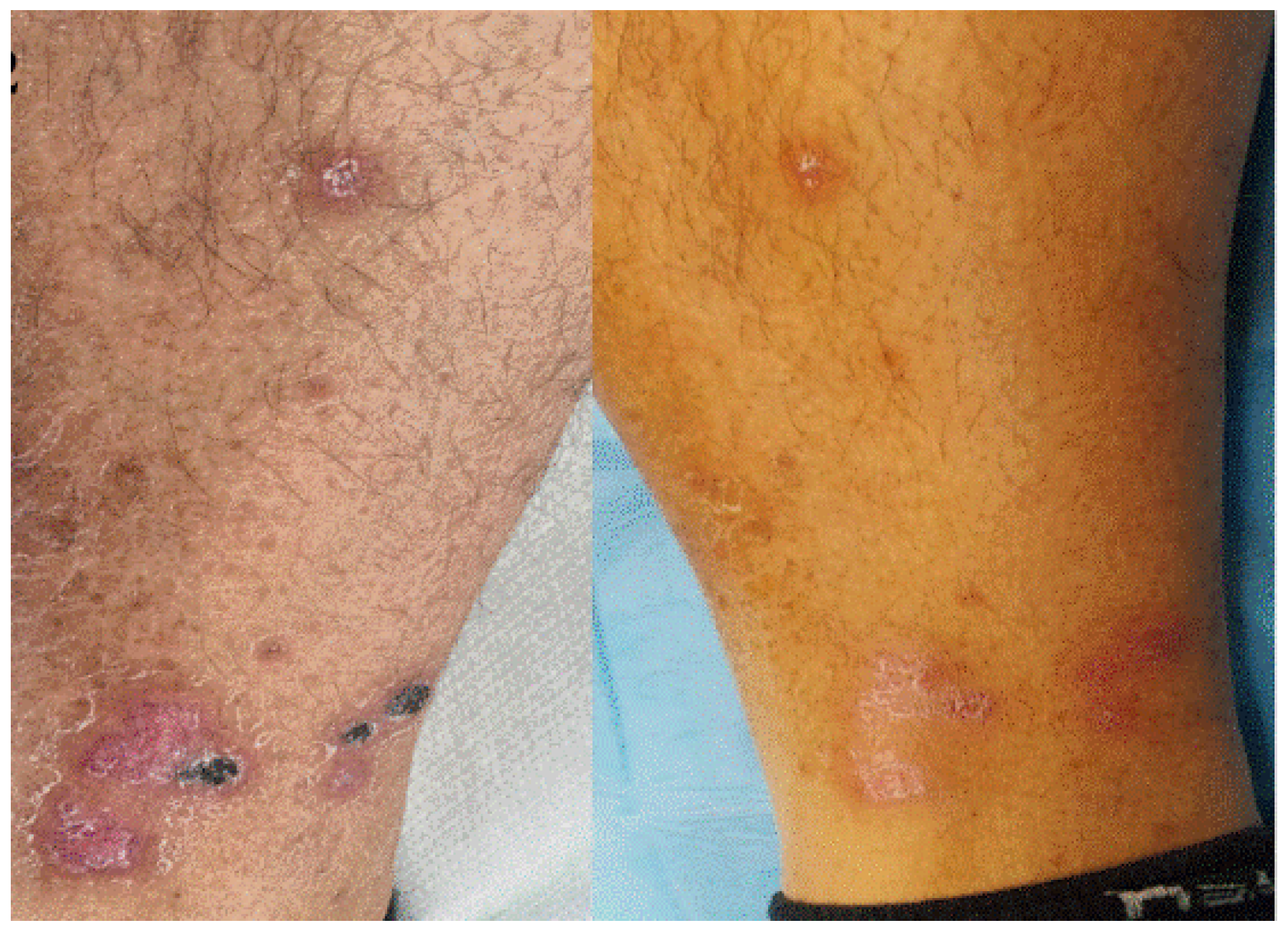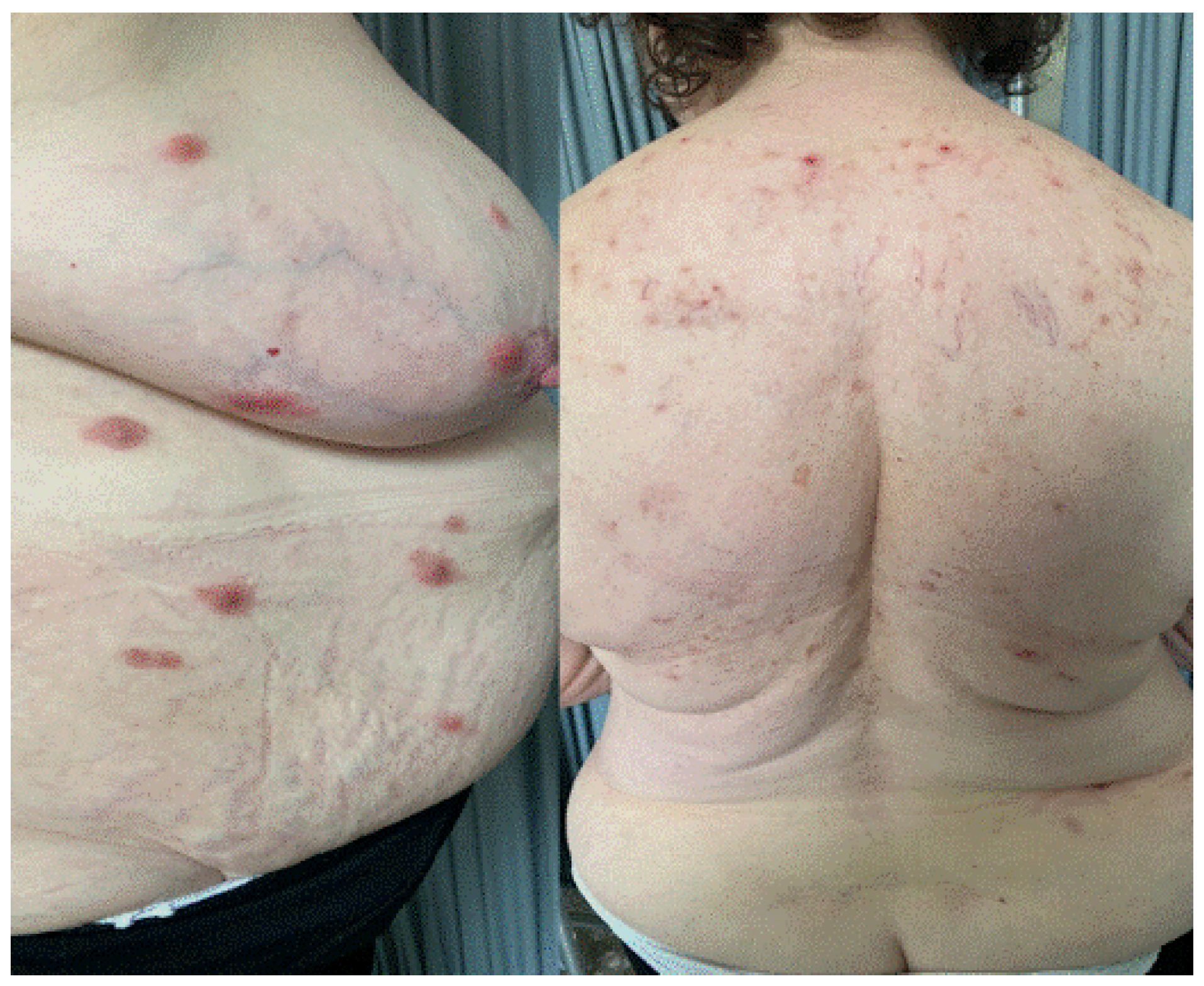Cutaneous Reactions to COVID-19 Vaccines in a Monocentric Study: A Case Series
Abstract
:1. Introduction
- mRNA vaccines: Pfizer-BioNTech, BNT162b2, USA, MODERNA, mRNA1273, USA;
- Viral vector DNA vaccines: Oxford-AstraZeneca, AZD1222; Sputnik V, Gam-COVID-Vac; Johnson & Johnson, Ad26.COV2.S;
- Protein subunit recombinant vaccines;
- Inactivated and attenuated vaccines [1].
2. Case Series
3. Local Skin Reaction to Injection Site and Urticarial Manifestation
4. Acral Vasculitis and Palpable Purpura
5. Sweet Syndrome
6. Parapsoriasis
7. Dermatomyositis-like Eruption
8. Acute Generalized Exanthematous Pustulosis (AGEP)
9. Cutaneous Lupus Erythematosus
10. Erythema Nodosum
11. Erythema Multiforme-like Rash
12. Discussion
Author Contributions
Funding
Institutional Review Board Statement
Informed Consent Statement
Data Availability Statement
Conflicts of Interest
References
- Ayatollahi, A.; Hosseini, H.; Firooz, R.; Firooz, A. COVID-19 vaccines: What dermatologists should know? Dermatol. Ther. 2021, 34, e15056. [Google Scholar] [CrossRef] [PubMed]
- Agaronov, A.; Makdesi, C.; Hall, C.S. Acute generalized exanthematous pustulosis induced by Moderna COVID-19 messenger RNA vaccine. JAAD Case Rep. 2021, 16, 96–97. [Google Scholar] [CrossRef] [PubMed]
- Carpenter, T.; Konig, J.; Hochfelder, J.; Siegel, S.; Gans, M. Polyethylene glycol and polysorbate testing in 12 patients before or after coronavirus disease 2019 vaccine administration. Ann. Allergy Asthma Immunol. 2022, 128, 99–101. [Google Scholar] [CrossRef] [PubMed]
- Paolino, G.; Di Nicola, M.R.; Cantisani, C.; Mercuri, S.R. Pityriasis rosea infection in a COVID-19 patient successfully treated with systemic steroid and antihistamine via telemedicine: Literature update of a possible prodromal symptom of an underlying SARS-CoV-2 infection. Dermatol. Ther. 2021, 34, e14972. [Google Scholar] [CrossRef] [PubMed]
- Sernicola, A.; Dybala, A.; Gomes, V.; Maddalena, P.; Adotti, F.; Soda, G.; Muharremi, R.; Fino, P.; Del Duca, E.; Grieco, T. Lymphomatoid drug reaction developed after BNT162b2 (Comirnaty) COVID-19 vaccine manifesting as pityriasis lichenoides et varioliformis acuta-like eruption. J. Eur. Acad. Dermatol. Venereol. 2022, 36, e172–e174. [Google Scholar] [CrossRef] [PubMed]
- Grieco, T.; Ambrosio, L.; Trovato, F.; Vitiello, M.; Demofonte, I.; Fanto, M.; Paolino, G.; Pellacani, G. Effects of Vaccination against COVID-19 in Chronic Spontaneous and Inducible Urticaria (CSU/CIU) Patients: A Monocentric Study. J. Clin. Med. 2022, 11, 1822. [Google Scholar] [CrossRef] [PubMed]
- Camargo Coronel, A.; Jiménez Balderas, F.J.; Quiñones Moya, H.; Hernández Zavala, M.R.; Mandinabeitia Rodríguez, P.; Hernández Vázquez, J.R.; Zamora Zarco, S.; Aguilar Castillo, S.J. Dermatomyositis post vaccine against SARS-COV2. BMC Rheumatol. 2022, 6, 20. [Google Scholar] [CrossRef] [PubMed]
- Deucher, W.; Sukumar, S.; Cataland, S.R. Clinical relapse of immune-mediated thrombotic thrombocytopenic purpura following COVID-19 vaccination. Res. Pract. Thromb. Haemost. 2022, 6, e12658. [Google Scholar] [CrossRef] [PubMed]
- Parums, D.V. Editorial: SARS-CoV-2 mRNA Vaccines and the Possible Mechanism of Vaccine-Induced Immune Thrombotic Thrombocytopenia (VITT). Med. Sci. Monit. 2021, 27, e932899. [Google Scholar] [CrossRef] [PubMed]
- D’Ardes, D.; Boccatonda, A.; Cocco, G.; Fabiani, S.; Rossi, I.; Bucci, M.; Guagnano, M.T.; Schiavone, C.; Cipollone, F. Impaired coagulation, liver dysfunction and COVID-19: Discovering an intriguing relationship. World J. Gastroenterol. 2022, 28, 1102–1112. [Google Scholar] [CrossRef] [PubMed]
- Majid, I.; Mearaj, S. Sweet syndrome after Oxford-AstraZeneca COVID-19 vaccine (AZD1222) in an elderly female. Dermatol. Ther. 2021, 34, e15146. [Google Scholar] [CrossRef] [PubMed]
- Darrigade, A.S.; Théophile, H.; Sanchez-Pena, P.; Milpied, B.; Colbert, M.; Pedeboscq, S.; Pistone, T.; Jullié, M.L.; Seneschal, J. Sweet syndrome induced by SARS-CoV-2 Pfizer-BioNTech mRNA vaccine. Allergy 2021, 76, 3194–3196. [Google Scholar] [CrossRef] [PubMed]
- Kang, S.Y.; Park, S.Y.; Kim, J.H.; Lee, S.M.; Lee, S.P. COVID-19 vaccine-induced acute generalized exanthematous pustulosis. Korean J. Intern. Med. 2021, 36, 1537–1538. [Google Scholar] [CrossRef] [PubMed]
- Wu, R.W.; Lin, T.K. Oxford-AstraZeneca COVID-19 vaccine-induced acute localized exanthematous pustulosis. J. Dermatol. 2021, 48, e562–e563. [Google Scholar] [CrossRef] [PubMed]
- Kim, Y.M.; Shin, E.C. Type I and III interferon responses in SARS-CoV-2 infection. Exp. Mol. Med. 2021, 53, 750–760. [Google Scholar] [CrossRef] [PubMed]
- Nln, I.; Fernandez-Ruiz, R.; Wampler Muskardin, T.L.; Paredes, J.L.; Blazer, A.D.; Tuminello, S.; Attur, M.; Iturrate, E.; Petrilli, C.M.; Abramson, S.B.; et al. Interferon pathway lupus risk alleles modulate risk of death from acute COVID-19. medRxiv 2021, in press. [Google Scholar] [CrossRef] [PubMed]
- Buján Bonino, C.; Moreiras Arias, N.; López-Pardo Rico, M.; Pita da Veiga Seijo, G.; Rosón López, E.; Suárez Peñaranda, J.M.; Sánchez-Aguilar Rojas, D. Atypical erythema multiforme related to BNT162b2 (Pfizer-BioNTech) COVID-19 vaccine. Int. J. Dermatol. 2021, 60, e466–e467. [Google Scholar] [CrossRef]







Publisher’s Note: MDPI stays neutral with regard to jurisdictional claims in published maps and institutional affiliations. |
© 2022 by the authors. Licensee MDPI, Basel, Switzerland. This article is an open access article distributed under the terms and conditions of the Creative Commons Attribution (CC BY) license (https://creativecommons.org/licenses/by/4.0/).
Share and Cite
Cantisani, C.; Chello, C.; Grieco, T.; Ambrosio, L.; Kiss, N.; Tammaro, A.; Tosti, G.; Paolino, G.; Pellacani, G. Cutaneous Reactions to COVID-19 Vaccines in a Monocentric Study: A Case Series. J. Clin. Med. 2022, 11, 3811. https://doi.org/10.3390/jcm11133811
Cantisani C, Chello C, Grieco T, Ambrosio L, Kiss N, Tammaro A, Tosti G, Paolino G, Pellacani G. Cutaneous Reactions to COVID-19 Vaccines in a Monocentric Study: A Case Series. Journal of Clinical Medicine. 2022; 11(13):3811. https://doi.org/10.3390/jcm11133811
Chicago/Turabian StyleCantisani, Carmen, Camilla Chello, Teresa Grieco, Luca Ambrosio, Norbert Kiss, Antonella Tammaro, Giulio Tosti, Giovanni Paolino, and Giovanni Pellacani. 2022. "Cutaneous Reactions to COVID-19 Vaccines in a Monocentric Study: A Case Series" Journal of Clinical Medicine 11, no. 13: 3811. https://doi.org/10.3390/jcm11133811





